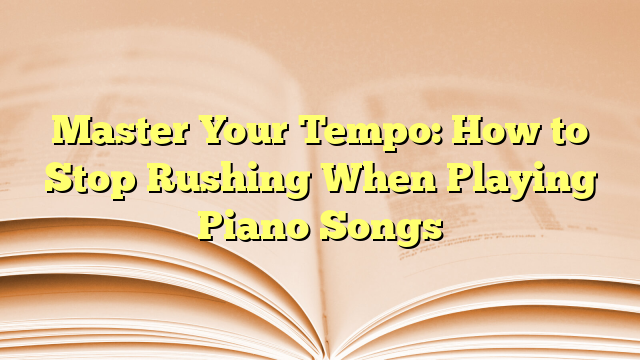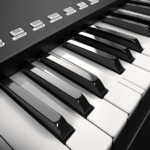Rushing through piano pieces is a common challenge that many pianists face, whether they're beginners or more experienced players. It's like trying to sprint through a beautiful garden without stopping to smell the flowers. But playing music isn't just about reaching the end; it's about enjoying the journey, note by note.
To tackle this issue, it's crucial to understand the root causes of rushing and learn strategies to maintain a steady pace. From setting the right mindset before sitting at the piano to practical tips that can be applied during practice, there are effective ways to ensure music flows beautifully and effortlessly. Let's dive into how to stop rushing and start making every piano song a masterpiece to remember.
Understanding the Impact of Rushing in Piano Playing
Rushing through piano pieces is a common challenge that affects musicians of all skill levels. When a pianist rushes, they often compromise the emotional depth and technical precision of the piece. This section dives into the reasons why pacing is crucial in music and the consequences of not maintaining it.
First and foremost, music is a language. Just as in spoken language, the pacing and emphasis carry the message and the emotions. In piano playing, rushing through pieces can blur the lines between notes and phrases, making it difficult for listeners to grasp the emotional essence of the piece. Each piece of music tells a story, and when notes and rests are not given their due time, the story becomes rushed and loses its impact.
Moreover, rushing can lead to technical inaccuracies. The desire to play fast often stems from a misunderstanding that speed equates to skill. However, precision and control are what truly define a pianist's mastery. When fingers sprint across keys without proper timing, the risk of errors increases, and the overall performance suffers.
To highlight the difference pacing can make, consider the following comparison of playing a piece at different tempos:
| Tempo | Emotional Impact | Technical Accuracy |
|---|---|---|
| Slow | High | High |
| Ideal | Very High | Very High |
| Fast | Low | Low |
Playing too slowly can also detract from a piece's intended emotion and energy, but an ideal pace—one that respects the composer's markings and the piece’s emotional landscape—yields the highest emotional impact and technical accuracy.
The physical effects of rushing cannot be overlooked. Playing under pressure and at an unnaturally fast tempo can lead to muscle tension, reducing fluidity and expressiveness. This tension not only hinders performance but can also cause strain and injuries over time. Pianists should aim for a relaxed state where they can fully engage with the music, allowing for a performance that feels both effortless and deeply expressive.
Understanding the roots of rushing is the first step in addressing it. For many, the drive to rush stems from anxiety, a desire to impress, or simply a habit formed from repeating the same mistakes during practice. It’s important for pianists to reflect on their motivations and recognize the moments when they’re tempted to rush, allowing them to consciously adjust their pace.
Analyzing the Root Causes of Rushing

When pianists find themselves habitually rushing through pieces, it's often a symptom of deeper issues that go beyond mere impatience or a lack of technical skills. Understanding these root causes is the first step toward cultivating a more measured and expressive performance.
One major factor is anxiety. Many musicians, whether playing solo or with an ensemble, experience performance anxiety. This nervous energy can translate into a faster tempo, as the player subconsciously tries to hasten the end of the performance. The desire to impress or prove oneself can exacerbate this, leading to a cycle where the pianist rushes more, which in turn increases mistakes and anxiety.
Another contributing factor is inadequate preparation or practice. When pianists don't spend enough time internalizing the tempo, dynamics, and emotional nuances of a piece, they may default to playing it at a uniform, often quicker pace. This lack of familiarity can prevent them from fully expressing the music's emotional range, resulting in a performance that feels rushed and lacks depth.
Moreover, technical limitations also play a crucial role. Pianists who attempt pieces beyond their current skill level may find themselves unable to maintain the proper tempo, especially in complex or fast passages. Instead of slowing down to match their technical capabilities, they might rush through these sections, compromising both accuracy and musicality.
Finally, misunderstood musical expressions contribute to rushing. Some musicians might interpret terms like 'allegro' (fast) or 'vivace' (lively) as invitations to push the tempo to the extreme, not realizing that these directions still require control and modulation based on the piece's overall emotional landscape.
By addressing these root causes, pianists can start to develop strategies to mitigate rushing. Techniques like mindful practice—where they focus on each note and its purpose—can help reduce anxiety and improve familiarity with the music. Additionally, setting realistic goals and gradually increasing the difficulty of pieces can help manage technical limitations and misunderstandings about musical expressions.
Incorporating slow practice sessions into their routine allows pianists to dissect difficult passages and understand how they fit into the broader emotional context of the piece. This method not only enhances technical proficiency but also deepens the musician's connection to the music, allowing for a performance that's both technically accurate and emotionally compelling.
Developing a Mindful Practice Routine

To stop rushing when playing piano songs, developing a mindful practice routine is essential. This approach involves cultivating an awareness of each note, transition, and emotion conveyed throughout a piece. By focusing on the present moment, pianists can significantly improve their connection to the music, leading to a more controlled and expressive performance.
The cornerstone of a mindful practice routine is slow practice. This technique requires the pianist to play through pieces at a significantly reduced tempo. The objective isn't merely to play slowly but to observe and internalize every detail of the music. During slow practice, pianists should pay close attention to:
- Finger placement and movement
- Dynamics and articulation
- Emotional expression of each section
Slow practice allows for the correction of errors and the reinforcement of correct technique, mitigating the tendency to rush through difficult passages.
Incorporating breathing exercises into practice sessions is another effective method for cultivating mindfulness. Before beginning to play, taking a few deep, slow breaths can help center the pianist's focus and reduce anxiety. Breathing exercises can also be woven into the practice itself, with the musician taking intentional breaths at key transitions within the piece.
Setting realistic, achievable goals for each practice session is crucial. Rather than attempting to master an entire piece in one sitting, pianists should break the music into manageable sections. This approach encourages a deeper understanding of each part, ensuring that the pianist gives adequate attention to learning and memorizing the details of the music. Goals for a practice session might include:
- Mastering a specific measure or phrase
- Improving dynamics in a particular section
- Focusing on the accurate execution of rhythm
The use of metronomes is a highly recommended practice to prevent rushing. Starting with a tempo below the performance speed, a pianist can gradually increase the pace, ensuring accuracy and control are maintained. This gradual increase in speed helps build muscle memory and confidence, which are vital for controlling tempo during performance.
Regular recording of practice sessions offers valuable insights into progress and areas needing improvement. Listening back to recordings, musicians can identify moments when they may be rushing and understand better how their performance sounds to an audience. This self-assessment tool fosters a heightened sense of musical awareness and encourages a conscientious approach to practice.
Techniques to Maintain a Steady Tempo

One of the foundational aspects of delivering a flawless piano performance is maintaining a steady tempo. Without it, the cohesion and emotional impact of the music can be lost. Here, we explore techniques that ensure pianists keep a commanding grip on tempo, making their performances evocative and captivating.
Firstly, using a metronome is not just recommended; it's essential. This device serves as an auditory guide, helping musicians internalize a consistent pace. By setting the metronome to a slower tempo than the performance speed, pianists can meticulously work through complex passages, gradually increasing the speed as their comfort and accuracy improve. It's a methodical approach that ingrains tempo stability into muscle memory.
Another effective strategy is the segmentation of pieces into manageable sections. Instead of tackling a whole composition in one go, breaking it down allows for focused practice on areas that are particularly challenging or prone to rushed playing. This technique not only facilitates detailed work on rhythm and pace but also boosts overall confidence in performance.
Incorporating breathing exercises into piano practice can also do wonders for tempo control. Just like vocalists and wind instrument players, pianists too can benefit from controlled breathing to steady their pace. By taking deep, mindful breaths, musicians can align their physical and emotional state with the tempo of the music, reducing the likelihood of rushing through pieces.
Recording practice sessions offers invaluable insights into tempo consistency. Listening back to a practice session can uncover unintentional fluctuations in speed that might not be noticeable in the moment. This self-feedback mechanism encourages critical listening and fosters improvements in tempo control.
Lastly, setting realistic practice goals is crucial. Ambitious goals can lead to frustration and rushed practicing as one strives to meet unrealistic expectations. Instead, achievable goals aligned with one's current skill level promote gradual, steady progress and a more disciplined approach to maintaining tempo.
Together, these techniques provide a comprehensive framework to address the challenge of rushing. They emphasize the importance of patience, persistence, and precision in mastering the art of maintaining a steady tempo during piano performances.
Cultivating Patience and Musical Expression

Rushing through piano pieces is a common challenge that many pianists face. It's not just about losing control of the tempo, but it can also diminish the emotive power of the music. To truly convey the soul of a piece, a pianist must learn the art of patience and musical expression. This requires more than just technical skill; it involves a deep connection with the music and an understanding of its narrative flow.
One effective strategy for cultivating patience is to practice mindfulness during playing. By focusing on the present moment and the physical sensations of playing, pianists can tune in more closely to the nuances of the music. They should pay attention to the texture of the keys under their fingers, the sound of each note, and the resonance of the piano. This mindful approach helps to slow down the impulse to rush, allowing space for the music to breathe and its expressive qualities to shine through.
Another crucial aspect is to develop a sound understanding of the emotional content and structure of the pieces they play. Musicians should study their pieces beyond the notes on the page, exploring the historical context, the composer’s intended emotional message, and the overarching narrative. This deep dive into the music's background provides a richer palette for expression and a more measured approach to tempo.
Incorporating dynamics into practice sessions is another vital technique. Dynamics aren't just volume control—they're the heartbeats of musical expression. By experimenting with different dynamics, pianists can discover how varying intensities affect the pacing and mood of a piece. They should start by playing sections slowly with exaggerated dynamics to feel the emotional weight each note can carry. This exercise not only enhances musical expression but also naturally encourages a slower tempo, giving each note and phrase its moment in the spotlight.
To reinforce patience and control, slow practice with a metronome is invaluable. Pianists might set the metronome to a tempo much slower than the piece's performance speed. This deliberate practice forces them to linger on each note and rest, fostering a mental and physical recalibration towards slower, more controlled playing. The challenge is not to see this slow practice as a mere exercise but as an opportunity to explore the depth of the music.
| Technique | Benefit |
|---|---|
| Mindfulness | Connects player with the nuances of the music |
| Historical study | Provides context for emotional expression |
| Dynamics |
Conclusion
Mastering the art of not rushing when playing piano songs is a journey that requires patience, mindfulness, and a deep emotional connection with the music. By focusing on the present and embracing the beauty of each note, pianists can transform their performances into expressive masterpieces. Slow practice isn't just a technique; it's a pathway to understanding the soul of the music. So take a breath, slow down, and let the music guide you to a place where every note tells a story. Remember, it's not about reaching the end of the piece but about the journey through the music's landscape. Let's make every performance an exploration, an adventure where every note counts.
Harlan Kilstein began playing piano during covid with no piano background at all. He taught himself how to play learning what to do and what not to do.
Today he's an advanced intermediate player and can help you grow in your skills because he learned all this on his own.








